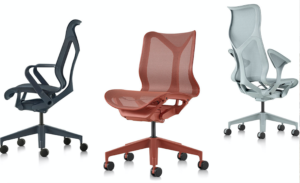Author: Brett Weiss PT, DPT, CEAS (Physical Therapist & Certified Ergonomic Assessment Specialist)
Top 6 Features to Look for in an Ergonomic Chair

Photo Credit: Herman Miller
The internet is a vast sea filled with products from companies promising you the world if you just buy their chair. Let’s talk about what to look for in a chair and highlight our non-negotiable features they must have to call them “ergonomic”. The key term here is “adjustable”. The more adjustable parts, the better you can customize the chair to ensure a perfect fit. Don’t go cheap on a chair, anything under $300 is almost always a waste of your money. Invest in furniture that ensures you remain healthy for years to come. Spend some money and invest in furniture with at least a 10 year warranty. If they don’t back their products, move on.
Adjustable Height
Depending on your desk height you want to make sure that the chair has the ability to lower and rise. Most standard desks are at least 29 inches high. When setting the height make sure your feet can rest firmly on the floor or a footrest with your knees at a 90 degree angle. Too high can lead to leg swelling and nerve pain due to compression in the popliteal space behind the knee. Too low and you’ll be overloading your pelvis and spine, which can lead to back pain and sciatica. Gaming chairs, which have many problems, have become increasingly more popular and tend to be too low for the average desk.
Adjustable Seat Depth
The better ergonomic chairs will provide you the opportunity to shorten or lengthen the seat to allow more or less space behind your knees. The Herman Miller Embody chair is a great example of this. This is sacred space so make sure you keep about 3-4 inches of clearance here; any more you’ll be sliding off the chair, any less can lead to leg swelling from reduced circulation.
Adjustable Lumbar Support
Make sure your chair’s lumbar pad can move up and down. We are all different heights and you want to make sure the support goes to the small of your back. Support should be small enough to not over-arch your back and large enough to keep you from rounding out your lower back as the day goes on.
Fully Adjustable Armrests
This is a BIG one for maintaining good posture! Find a chair that has armrests that can adjust up/down, turn in/out and narrow/wide. Most chairs will go up and down, many others turn in or out, but a few give you the option to adjust to the width of your torso. For those with neck pain or tightness this is a key component. When looking at the height of the armrests, they should be set even with the surface your keyboard is on.
Seat Cushion
Here is where you want to pay up for quality. A lot of cheaply made chairs tag themselves as “ergonomic”. The many adjustable features give the illusion that the chair is quality made. Where they fall short is often in the density of the seat cushion. Look for the cushion to be no less than 1.5”-2”.
Wheel Casters
Most people pay no attention to this when buying a chair but this is a BIG mistake! Wheels are made for the surfaces they are designed to be used on. If your seat has wheels designed for carpets (plastic wheels with no rubber grip) and you’re using it on wood or tile flooring, you’ll be sliding all over the place when typing. If you’re not sliding you’re probably tucking your feet under you all day, hello tight hamstrings!
You’ve got the Ferrari…Now learn how to drive
Once you grab that amazing new chair you’ll want to learn how to use it. I’m not just talking about how to adjust the chair (that will come in the instruction manual). I’m talking about how to take this chair and incorporate it into the larger workspace. Half the battle is getting the right tools…now it’s time to talk about how your chair fits to the desk, monitor, keyboard and mouse. How does it all work with the lighting and flooring in your space. All these questions and more can be sorted out quickly in a Virtual Ergonomic Assessment. For more information on our virtual home office assessments reach out to us at info@jamesfowlerpt.com.
You can also check out our Virtual Ergonomics Open House at the link below to get some more tips on how to better set up your in-home office. Virtual Ergonomics Open House (5/26/20)
Dr. Brett Weiss, DPT, CEAS
Physical Therapist & Certified Ergonomic Assessment Specialist
